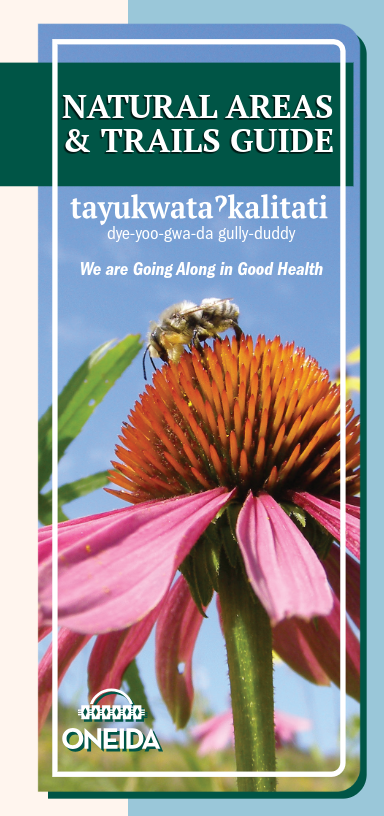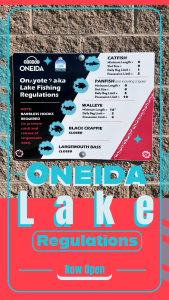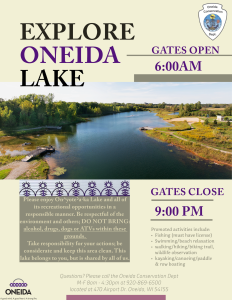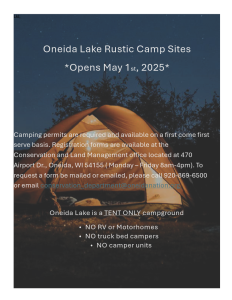Enjoying the Outdoors
Welcome

Natural Areas Guides & Resources
Please click on the link or map cover below to view the complete Oneida Reservations Map of Trails & Natural Areas.
Oneida Nation Wildlife
BIRDS
The diversity of habitats from wetlands to upland forest provides breeding and refuge for nearly 200 bird species on the Reservation. In addition to the game species like pheasants, wild turkeys, and ruffed-grouse, large numbers of nongame species live here year round while some make use of the area in migration and others make the Reservation their winter home. Many of the bird species making use of Reservation habitats for breeding are becoming rare elsewhere. These include wetland birds such as great egrets, pied-billed grebes, black terns, and least bitterns; grassland birds such as bobolinks, eastern meadowlarks, vesper sparrows, field sparrows, and sedge wrens; and forest birds like the eastern wood peewee, gray catbird, mourning warbler, American redstart, Baltimore oriole, and scarlet tanager.
BUGS & INSECTS
Wonder about the biological health of a Reservation stream, lake or wetland?
The Oneida Nation Water Resources Program, in addition to monitoring water quality and fish communities, also monitors the aquatic invertebrates, or “bugs”, annually at several sites on the Reservation. We compile the information and use to see where we are at in restoring these waters.
Have a “bug” you need identified? Although we do not monitor for terrestrial bugs, or bugs that live on land, we can usually tell you what they are if you bring them in.
Fish
Oneida waters have a great variety of fish. Efforts continue to increase the numbers and varieties for the community to harvest.
Amphibians
The Oneida Reservation’s large blocks of diverse wetlands surrounded by natural uplands provide habitats for at least half a dozen amphibian species. Some species require dry uplands for most of the year (wood frog, tree frog), wintering on the ground’s surface and breeding in unpolluted ponds lacking predatory fish. Some species (leopard frog, spring peeper, green frog), spend their winters in the mud associated with wetland ponds or streams.
Long term maintenance of unpolluted wetland ponds and surrounding upland habitats are critical to ensure that amphibian diversity will continue for future generations to enjoy.
Reptiles
Large numbers of reptile species make their homes in a variety of wetland habitats. Many reptile species are declining throughout their range due to habitat loss, pollution, conflicts with human development and chemical use. At least two turtle species that breed on the Reservation are on Wisconsin’s threatened list as are several of the snake species that live here. Reptiles are sometimes thought of as ‘creepy’, but all species contribute to the matrix of life. Each species lost leads us closer to a breakdown of our natural ecosystems. Protecting all these species is critical for a healthy system.
MAMMALS
The Oneida Reservation is the year-round home for dozens of mammal species. From star-nosed moles to ground squirrels, voles to otters, raccoons to tree squirrels.
Live, Sustain, Grow Plan
The Live Sustain Grow Plan was created to provide direction for resource management planning for Oneida’s Seven Generations and adds detail to the Natural Resources and Environmental Protection sections of the Oneida Comprehensive Plan.
- It is a tool for addressing gaps in the land use plan, zoning ordinance, sustainable forestry management plan, shoreland ordinance, and farm policy.
- Supports a GTC request that the rural character of the Reservation be protected, curbs development in rural areas to protect hunting and fishing.
- Establishes a framework for land use and protection programs.
- Preserves, protects, and manages the resources of the Reservation.
- Identifies needs for improvement in resource management policies and procedures.
- Solicits community input on resource management decisions.
- Provides for cultural needs of current and future tribal members.
Live Sustain Grow Plan
Table of Contents
Vision Statement
Executive Summary
Introduction
The Living Systems of the Oneida Reservation
Chapter 1 – Sustaining Habitat for Wildlife
Chapter 2 – Maintaining Diverse and Healthy Forests
Chapter 3 – Fish in Our Waterways
Chapter 4 – Wetlands, Streams, and Surface Waters
Chapter 5 – Farmlands that Provide
Chapter 6 – Activities that Sustain Us
Chapter 7 – The Resources for Our Future
Chapter 8 – Mining and Mineral Resources
Chapter 9 – Managing Our Waste Products
Chapter 10 – Invasive Plants and Animals that Displace Our Native Habitats
Onyota'aka Lake (Oneida Lake)
Enjoying your visit
Onyota’aka Lake has been closed to the public and under construction to increase its size, improve recreation opportunities and add additional amenities that will include park equipment and complete camping opportunities as the lake site continues to develop in the future. When open, we want to keep the property safe and enjoyable for all users and remind all of the following:
- Use of alcohol and fireworks/open fires is prohibited
- Use of any motor vehicles on grounds, except where permitted is prohibited The Oneida Nation has many resources and strives to create a beautiful and healthy environment for our community. Yaw^ko and enjoy your summertime activities!
Violations of any of these prohibitions, or others including leaving rubbish, bringing domestic animals or damage to property may carry forfeitures of $300 – $900.
Oneida Lake Fishery Info
The Water Resources program conducted the first fishery survey of Oneida Lake in early June 2016, with the cooperative assistance of fisheries biologists from the US Fish and Wildlife Service – Green Bay Fish and Wildlife Conservation Office. The purpose of the survey was to develop baseline information to help guide decisions about fishing regulations and future stocking efforts.










